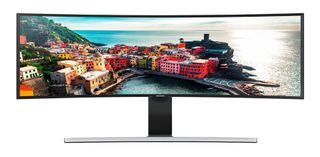Samsung to produce ridiculously huge double-wide display panels
Skip the dual monitors and messy bezels and just get a single display instead.

Samsung has plans to make 32:9 uberwide displays, officially called 'double full HD' (DFHD), according to TFTCentral. The panel will be 49-inches wide, with a 3840x1080 resolution. It's basically the equivalent of a pair of 27-inch 1080p displays, built as a single panel. The panel will feature an 1800R curvature, which is far curvier than what we see on 21:9 aspect ratio displays—and the extra curve makes sense given the size of the panel.
Perhaps more important for gaming considerations, the panel will also support either G-Sync or FreeSync, depending on the specific vendor implementation, with a maximum refresh rate of 144Hz. The panel will also use VA technology, which means good viewing angles and contrast ratios. It's is slated for production starting September 2017. I'm not sure I really want to worry about game support for 32:9, given we're still having issues with complete 21:9 support, but if you're a fan of surround gaming it should be quite the experience.
Samsung also has plans for a similar 3840x1200 panel, which they're oddly calling a 29:9 aspect ratio (it's technically 32:10 or 16:5). This will be a 44-inch diagonal, again with an 1800R curvature and using VA technology. Some might appreciate the extra vertical pixels, and the result is like having dual 24.7-inch 1920x1200 displays, only built from a single panel. Unlike the above, there will reportedly be both 60Hz and 144Hz (with the potential for G-Sync/FreeSync). Production is also set to start in September 2017, which means we'll start seeing retail displays in 2018.
The biggest gaming news, reviews and hardware deals
Keep up to date with the most important stories and the best deals, as picked by the PC Gamer team.
Jarred's love of computers dates back to the dark ages when his dad brought home a DOS 2.3 PC and he left his C-64 behind. He eventually built his first custom PC in 1990 with a 286 12MHz, only to discover it was already woefully outdated when Wing Commander was released a few months later. He holds a BS in Computer Science from Brigham Young University and has been working as a tech journalist since 2004, writing for AnandTech, Maximum PC, and PC Gamer. From the first S3 Virge '3D decelerators' to today's GPUs, Jarred keeps up with all the latest graphics trends and is the one to ask about game performance.
Most Popular






